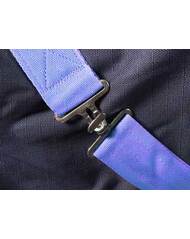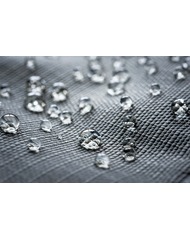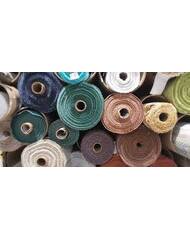Horse Rug Insulation Guide: Choosing the Right Polyfill Weight

Understanding Polyfill in Horse Rugs | Choosing the Right Fill Weight for Australian Winters
Updated September 2025
A practical guide for Australian horse owners on how polyfill insulation affects warmth, comfort, and performance - helping you choose the right rug weight for every season.
When it comes to keeping your horse comfortable and protected during the colder months, the type and amount of insulation in their rug can make all the difference. One of the most common materials used for thermal insulation in horse rugs is polyfill - but what exactly is it, and how does it work?
What Is Polyfill in Horse Rugs?
When winter hits, a properly insulated horse rug can make all the difference. One of the key components of a Delzani winter horse rug is the polyfill lining - a lightweight synthetic fibre designed to retain warmth by trapping heat in tiny air pockets.
Much like insulation in your home, polyfill helps regulate body temperature by reducing heat loss. The thicker and denser the fill, the better its insulating performance.
Understanding Polyfill Weights: What Does 100g, 200g, or 300g Mean?
The weight of polyfill is measured in grams per square meter (gsm). This isn’t the total weight of the rug - but the density of insulation used throughout.
- 100g Polyfill = Light warmth
- 200g Polyfill = Medium warmth
- 300g Polyfill = Heavy warmth
The higher the number, the more body the insulation has, and the more warmth it will provide.
Choosing the Right Fill Weight
Selecting the appropriate polyfill weight depends on a few key factors:
- Climate: In milder regions, a medium-weight rug (around 200g) may be sufficient. In colder areas, especially during deep winter, a heavy rug (around 300g) offers better protection without the need for multiple layers.
- Horse’s Coat Condition: Clipped horses or those with finer coats typically require more insulation.
- Age and Health: Senior horses or those with health concerns often benefit from extra warmth.
- Rugging Strategy: Some riders prefer using a single heavy rug, while others layer under rugs beneath a medium-weight turnout for adjustable warmth.
Understanding Quality Differences in Polyfill
At Delzani, we carefully source high-quality polyfill with excellent loft recovery and long-term durability. Lower-cost polyfill - often sourced from inferior suppliers - can compress quickly, reducing insulation performance over time. Even a 300g rug made from poor-quality polyfill may perform like a 200g rug from a superior manufacturer.
Compression and Longevity
Over time, all polyfill will experience some compression, especially with frequent use. As the fill flattens, its ability to trap air diminishes, reducing insulation. This is why some horse owners prefer a 300g fill - it maintains a higher level of warmth for longer, even as the fill begins to settle with use.
Medium vs. Heavy Fill Rugs
Medium Weight (Polyfill: 200grm)
- Best for: Transitional weather or warmer climate winters
- Specifics: Offers good insulation without overheating and can be paired with under-rugs as needed.
Heavy Weight (Polyfill: 300grm)
- Best for: Cold climates or clipped horses
- Specifics: Often sufficient on its own without requiring layers, offering simplicity and time savings.
Polar Fleece vs Polyfill: What’s the Difference?
Some turnout rugs feature polar fleece lining instead of polyfill. While polar fleece adds light warmth and excellent moisture-wicking, it cannot match the thermal retention of a true 200g or 300g polyfill rug.
Use polar fleece rugs when:
- Your horse is warm-natured
- You’re bridging the gap between seasons
- You want to wick away moisture under a rain sheet
Should You Choose 200g or 300g?
Both have their place:
- Go with 200g if you want more versatility and plan to layer
- Opt for 300g if you prefer one-and-done warmth and live in cooler regions
Compression is also a factor: heavier fills maintain their structure better across the season, meaning 300g rugs will hold warmth longer without becoming flat and ineffective.
Delzani’s Recommendation
If you’re looking for the best winter horse rugs in Australia, Delzani’s Winter Turnout Range is engineered for performance, comfort, and durability.
- Montana 'Mid' (200g): Ideal for moderate winter use across most of Australia
- Denver 'Heavy' (300g): Designed for deep winter warmth, no underrugs needed
Explore the Delzani Winter Rug Collection [Link here]
Don’t Just Look at Numbers—Look at the Horse
Remember, horses - like people - acclimate to their environment. A 300g rug might be perfect for a Queensland horse in winter just as it would be for one in Victoria. What matters most is your horse’s comfort, coat condition, and how early or late in the season you begin rugging.
If you’re unsure whether a 200g rug will be too warm, consider starting with an unlined rain sheet and layering with under rugs as needed. This offers more flexibility to adjust insulation levels based on fluctuating temperatures.
Written by Jane Griffiths - An experienced Australian horse owner and product developer with over three decades immersed in equestrian life. Jane has spent years refining horse rugs, tack, and riding apparel to better suit Australian climates. She has enjoyed countless weekends at gymkhanas, show jumping events, and pony club competitions with her daughter, and still loves hitting the trails with friends whenever she can. Her lifelong passion for horses and hands-on understanding of equine comfort continue to shape her practical, rider-first approach to horse care and product design.
Leave a comment
Related Equestrian Guides
Delzani Horse Rug Sizing Guide
We have put together this comprehensive guide to help you purchase the ideal size Delzani horse rug.
Waterproof Horse Rugs & Winter Turnouts
Keep your horse cozy and dry during rainy and cold winter weather with Delzani's waterproof turnout horse rugs. Designed for comfort and warmth, our rugs provide reliable protection against harsh weather conditions. Shop now!
How to fit & adjust horse rug belly surcingles
Belly surcingles keep horse rugs secure, but only if fitted correctly. We answer common questions on what surcingles do, why they matter, and how proper adjustment ensures comfort, safety, and longer rug life for horses in Australian conditions.
Wash Guide - Horse Rugs
To get the best life from your Delzani horse rug, taking a few simple washing precautions will go along way.
Understanding your horse rugs waterproofing
Learn how horse rug waterproofing and breathability really work, why membranes matter more than fabric, and how to test, care for, and choose rainsheets. Explore Delzani’s 600D Waratah and 1200D Wyndham rugs, built for tough Australian conditions.
A Guide to Delzani Horse Rug Fabrics
Managing and Preventing Queensland Itch in Horses
Banish the Itch: Managing and Preventing Queensland Itch in Horses
Understanding Denier: The Key Differences Between 600D and 1200D Turnout Rugs
Confused about 600D vs 1200D horse rugs? Learn what denier really means, how it affects toughness (not warmth or waterproofing), and when to choose Delzani’s Waratah 600D rainsheets for lighter use or Wyndham 1200D rainsheets for maximum durability.
Horse Rugging: 8 Common Mistakes Horse Owners Should Avoid This Summer
Rugging in the Australian summer can protect your horse from sun, flies and coat damage, but the wrong rug can cause overheating, rubbing and discomfort. Learn 8 common rugging mistakes and how to keep your horse cool, safe and comfortable this season.
Preventing Shoulder Rubs in Horses: Why Shoulder Guards Make a Difference
Protect your horse’s shoulders before rubs start - learn why they happen, how to prevent them, and why Australian riders trust Delzani Shoulder Guards to keep coats glossy, comfortable and show-ready all year round.
















